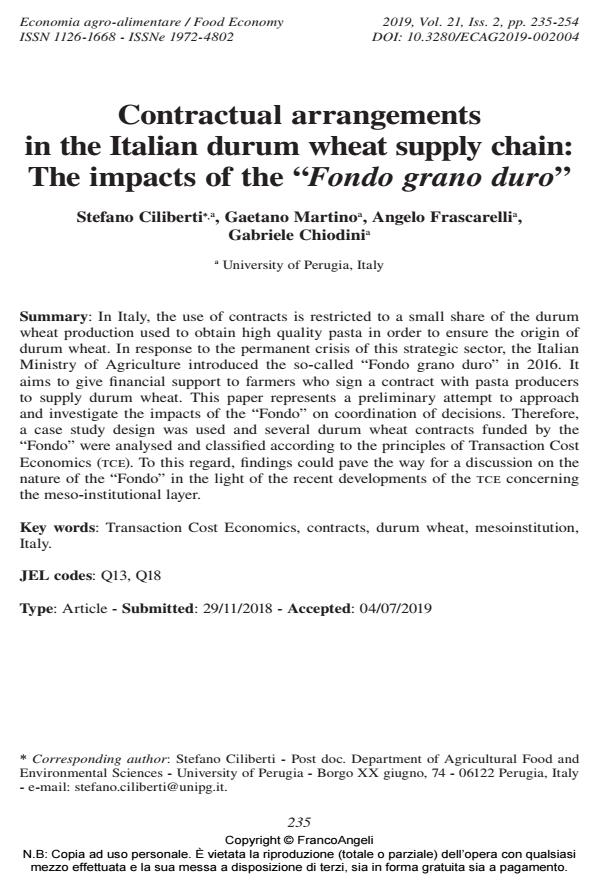Contractual arrangements in the Italian durum wheat supply chain: The impacts of the "Fondo grano duro"
Journal title ECONOMIA AGRO-ALIMENTARE
Author/s Stefano Ciliberti, Gaetano Martino, Angelo Frascarelli, Gabriele Chiodini
Publishing Year 2019 Issue 2019/2
Language English Pages 20 P. 235-254 File size 190 KB
DOI 10.3280/ECAG2019-002004
DOI is like a bar code for intellectual property: to have more infomation
click here
Below, you can see the article first page
If you want to buy this article in PDF format, you can do it, following the instructions to buy download credits

FrancoAngeli is member of Publishers International Linking Association, Inc (PILA), a not-for-profit association which run the CrossRef service enabling links to and from online scholarly content.
In Italy, the use of contracts is restricted to a small share of the durum wheat production used to obtain high quality pasta in order to ensure the origin of durum wheat. In response to the permanent crisis of this strategic sector, the Italian Ministry of Agriculture introduced the so-called "Fondo grano duro" in 2016. It aims to give financial support to farmers who sign a contract with pasta producers to supply durum wheat. This paper represents a preliminary attempt to approach and investigate the impacts of the "Fondo" on coordination of decisions. Therefore, a case study design was used and several durum wheat contracts funded by the "Fondo" were analysed and classified according to the principles of Transaction Cost Economics (tce). To this regard, findings could pave the way for a discussion on the nature of the "Fondo" in the light of the recent developments of the tce concerning the meso-institutional layer.
Keywords: Transaction Cost Economics, contracts, durum wheat, mesoinstitution, Italy.
Jel codes: Q13, Q18
- Matching ecological transition and food security in the cereal sector: The role of farmers' preferences on production contracts Stefano Ciliberti, Angelo Frascarelli, Gaetano Martino, in Frontiers in Sustainable Food Systems 1114590/2023
DOI: 10.3389/fsufs.2023.1114590
Stefano Ciliberti, Gaetano Martino, Angelo Frascarelli, Gabriele Chiodini, Contractual arrangements in the Italian durum wheat supply chain: The impacts of the "Fondo grano duro" in "ECONOMIA AGRO-ALIMENTARE" 2/2019, pp 235-254, DOI: 10.3280/ECAG2019-002004